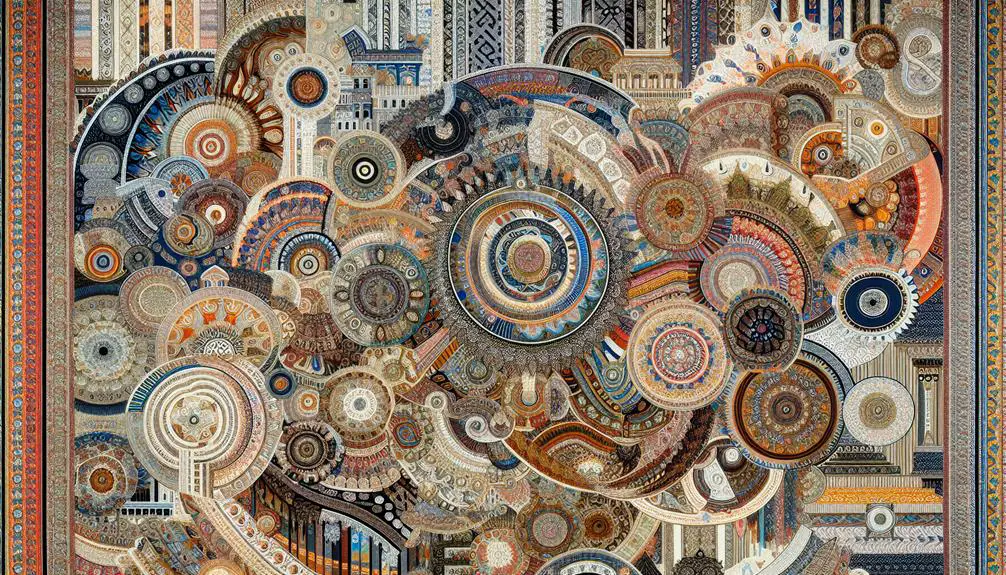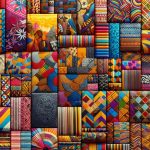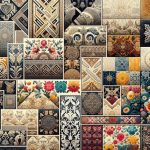Imagine examining a piece of Ancient Chinese brocade, its intricate patterns reflecting centuries-old traditions and stories. You'll find that textile patterns are much more than decorative elements; they're a window into the cultural, social, and artistic values of past civilizations. As you explore the evolution from Egyptian linen weaves to modern textile innovations, you'll see how these designs have adapted to changing architectural styles, religious beliefs, and societal norms. How do these historical influences shape today's textile industry, and what role do they play in contemporary design and sustainability efforts?
Table of Contents
Key Takeaways
- Ancient Chinese brocades showcased intricate designs and advanced silk weaving techniques with symbolic motifs like dragons and phoenixes.
- Egyptian linen weaves reflected cultural beliefs through mastery of warp and weft and the use of natural dyes.
- Greek and Roman textile patterns were influenced by pottery and architecture, emphasizing symmetry and mythological themes.
- Medieval European tapestries depicted rich storytelling and historical events, showcasing exceptional craftsmanship and symbolism.
- Modern textile innovations include smart fabrics, sustainable materials, digital printing, and 3D knitting, transforming traditional practices.
Ancient Chinese Brocades
Ancient Chinese brocades, renowned for their intricate designs and vibrant colors, showcase the advanced textile techniques developed during the Han Dynasty. You'll find that these brocades are more than just fabric; they're masterpieces of sophisticated silk production and weaving techniques that have stood the test of time.
The Han Dynasty's innovations in sericulture allowed for the creation of silk threads that were both strong and fine, setting the stage for the exquisite brocades that would follow.
To master these ancient techniques, you need to understand the meticulous process involved. First, the cultivation of mulberry trees guaranteed a steady supply of quality silk, as silkworms fed exclusively on their leaves. Once the silk threads were harvested, skilled artisans employed complex weaving techniques, such as the use of multiple heddles and intricate patterns, to produce the luxurious brocades.
These patterns often featured symbolic motifs like dragons and phoenixes, which were believed to bring good fortune.
Egyptian Linen Weaves
When you explore Egyptian linen weaves, you'll notice the ancient weaving techniques that created intricate patterns. These designs often held symbolic meanings, reflecting cultural and religious beliefs.
Linen wasn't just fabric; it played a significant role in daily life and rituals.
Ancient Weaving Techniques
Egyptian artisans mastered intricate linen weaves that set the foundation for textile craftsmanship. By honing their loom techniques, they created ancient fabrics that weren't only functional but also highly decorative. Understanding their methods can elevate your own textile work to new levels of sophistication.
Here are four key aspects of their weaving techniques:
- Vertical Looms: Egyptians primarily used vertical looms, which allowed them to produce fine, evenly textured linen. This type of loom gave them better control over tension and resulted in higher quality fabrics.
- Warp and Weft: Mastering the interplay between warp (vertical threads) and weft (horizontal threads) was essential. By manipulating these threads, they achieved various patterns and textures, from simple tabby weaves to more complex twills.
- Beating: To make sure that the weft threads were tightly packed, Egyptians used a technique called beating. This involved using a comb-like tool to press the weft threads down, creating a denser, more durable fabric.
- Natural Dyes: Egyptians utilized natural dyes derived from plants and minerals, which added vibrant colors to their textiles. This practice not only enhanced the visual appeal but also provided insights into their environment and resources.
Symbolism in Designs
Building on their expertise in weaving techniques, Egyptians infused their linen fabrics with symbolic designs that conveyed profound cultural and spiritual meanings. When you examine these ancient textiles, you'll notice how color symbolism played a crucial role. For instance, the use of blue often symbolized the Nile and rebirth, while green represented fertility and life. The Egyptians didn't just choose colors randomly; every hue was steeped in cultural influences and carried specific messages.
As you explore further into pattern interpretation, you'll find that motifs such as the ankh, lotus, and scarab were common. These symbols weren't simply decorative; they reflected significant aspects of Egyptian life and beliefs. Ankh patterns denoted life and immortality, lotus flowers signified creation and rebirth, while scarabs were associated with protection and resurrection.
Understanding the historical context of these designs enhances your appreciation for their complexity. The Egyptians wove their beliefs, values, and aspirations into their linen, creating textiles that were both functional and deeply meaningful.
Linen's Cultural Role
Consistently revered for its quality and durability, linen played an integral role in ancient Egyptian culture, from daily attire to intricate burial shrouds. As you explore Egyptian linen weaves, you'll uncover a tapestry rich with cultural traditions and artistic expression. Linen's significance extended beyond its practical uses, symbolizing purity and status within society.
To appreciate its cultural role, consider these key aspects:
- Everyday Wear:
Egyptians wore linen for its comfort in the hot climate. It was essential for both the elite and common folk, with quality and fineness indicating social status.
- Religious and Ceremonial Uses:
Linen was integral in religious rituals. Priests donned linen garments, believing the material to be spiritually pure.
- Mummification:
The deceased were wrapped in finely woven linen shrouds, reflecting the belief in an afterlife where they'd need high-quality garments.
- Artistic Expression:
The intricate patterns and weaves of linen showcased artistic prowess. Weavers created complex designs that depicted cultural narratives and religious motifs.
Greek and Roman Patterns
In the world of textile patterns, the intricate designs of Greek and Roman civilizations stand out for their symbolic meanings and artistic sophistication. Greek pottery often featured detailed geometric patterns and mythological scenes, which later inspired textile designs. You can see how these motifs, like the meander or Greek key pattern, have transcended time, lending elegance and structure to fabrics. Proficiency in these designs isn't just about copying shapes; it's about understanding their cultural context and the stories they tell.
Roman architecture's grandeur also influenced textile patterns. The Romans incorporated elements from their monumental buildings into their textiles, such as the use of acanthus leaves and intricate friezes. When you study these patterns, you'll notice their emphasis on symmetry and proportion, reflecting the architectural principles of the time. By appreciating these details, you can create textiles that not only capture the essence of Roman aesthetics but also pay homage to their engineering marvels.
Mastering Greek and Roman patterns in textiles isn't simply about replication. It's about immersing yourself in the historical and cultural nuances that make these designs timeless. This approach guarantees your work is both authentic and artistically enriched.
Medieval European Tapestries
When you explore Medieval European tapestries, you'll discover their rich symbolism and storytelling, capturing historical and mythical scenes.
These masterpieces showcase exceptional craftsmanship and techniques, reflecting the skill of medieval weavers.
Preserved through centuries, they leave a lasting legacy that continues to inspire and educate.
Symbolism and Storytelling
Medieval European tapestries weren't just decorative; they told stories rich with symbolism and cultural significance. As you explore these intricate artworks, you'll notice how color symbolism and storytelling are masterfully intertwined. Each hue carried specific meanings: blue signified loyalty, red symbolized power, and green represented growth and fertility.
These tapestries served as visual narratives that conveyed historical events, religious tales, and even moral lessons. The cultural significance of these pieces can't be overstated. They were more than mere wall hangings; they were a reflection of societal values and beliefs. Various motifs were used to communicate complex ideas and emotions, often depicting scenes of chivalry, biblical stories, and mythical creatures.
To understand the depth of their storytelling, consider the following elements:
- Heraldic Symbols: Often featured prominently to signify family lineage and honor.
- Religious Icons: Used to convey spiritual narratives and moral teachings.
- Nature: Elements like animals and plants symbolized different virtues and vices.
- Geometric Patterns: These often had hidden meanings related to numerology or cosmology.
Craftsmanship and Techniques
You can't fully appreciate the storytelling in medieval European tapestries without understanding the extraordinary craftsmanship and techniques behind their creation. These masterpieces were born from meticulous weaving techniques that required immense skill and precision. You'd find that artisans spent countless hours on each piece, carefully interlacing threads to craft intricate designs that conveyed deep cultural significance.
Mastering these weaving techniques wasn't just about dexterity; it was a form of historical craftsmanship that demanded a profound understanding of materials and dyes. The artisans didn't merely create fabric; they wove stories into the very fibers, turning each tapestry into a visual narrative rich with storytelling patterns.
You can see how each thread and knot played a role in bringing to life scenes of mythology, history, and daily life. Moreover, the cultural significance of these tapestries transcended their aesthetic value. They were often commissioned by nobility to showcase wealth, commemorate events, or even serve as political propaganda.
Preservation and Legacy
The conservation of medieval European tapestries safeguards that these intricate works of art continue to recount their stories centuries later.
You understand that these textiles aren't just decorative items but are vital pieces of cultural heritage. Preserving them involves sophisticated methods that guarantee their longevity and integrity.
To appreciate the efforts involved, consider these four essential preservation methods:
- Climate Control: Maintaining stable temperature and humidity levels prevents the fibers from deteriorating.
- Light Management: Reducing exposure to light, especially UV rays, helps in preserving the colors and fabric strength.
- Cleaning Techniques: Gentle cleaning methods are employed to remove dust and pollutants without harming the delicate threads.
- Restoration Practices: Skilled conservators repair damaged sections carefully, often using original materials and techniques.
Ottoman Empire Textiles
During the height of its power, the Ottoman Empire produced some of the most intricate and luxurious textiles in history. Ottoman textiles, renowned for their intricate designs, were emblematic of the empire's vast cultural influence and opulence. You'd find that the sophisticated patterns often included floral motifs, geometric shapes, and elaborate calligraphy, all skillfully woven into fabrics like silk, velvet, and brocade. These textiles weren't just decorative; they played a significant role in court ceremonies and were symbols of status and wealth.
As you explore further into Ottoman textile artistry, you'll notice the masterful use of color and texture. Artisans employed rich, vibrant hues such as deep reds, blues, and golds, which were derived from natural dyes. They meticulously crafted each piece, ensuring that every detail was executed with precision. The textiles often featured motifs such as tulips, carnations, and pomegranates, each carrying specific symbolic meanings.
Indian Block Printing
While Ottoman textiles mesmerized with their luxurious intricacy, Indian block printing captivates with its handcrafted precision and vibrant patterns. This ancient art form hails from regions like Rajasthan and Gujarat, where artisans meticulously carve wooden blocks to create intricate designs. You'll find that traditional techniques remain at the heart of this craft, with artisans dipping blocks into natural dyes and pressing them onto fabric with practiced ease.
To fully grasp the richness of Indian block printing, consider these essential elements:
- Carving the Blocks: Artisans hand-carve wooden blocks with precise tools, often taking days to complete a single design.
- Natural Dyes: Traditional techniques emphasize using natural dyes derived from plants, minerals, and insects.
- Stamping Process: The dyed blocks are rhythmically stamped onto the fabric, requiring a steady hand and keen eye for detail.
- Drying and Fixing: The printed fabric is then dried and sometimes treated to fix the colors, ensuring durability.
Contemporary interpretations of Indian block printing have seen designers experiment with new patterns and synthetic dyes, broadening its appeal. You'll notice that this fusion of old and new keeps the tradition alive while making it relevant for modern fashion and home décor.
African Kente Cloth
When you explore African Kente Cloth, you'll uncover its rich origins and deep cultural meanings tied to the Ashanti and Ewe peoples of Ghana.
This vibrant textile, traditionally worn during significant ceremonies, has now found modern adaptations in fashion and home decor worldwide.
Understanding its evolution helps you appreciate both its historical significance and contemporary relevance.
Origins and Cultural Meaning
African Kente cloth, known for its vibrant colors and intricate patterns, symbolizes cultural heritage and conveys deep social messages. Originating from the Akan people of Ghana, this textile is woven with profound cultural symbolism and reflects the rich tapestry of African history. As you explore the origins of Kente, you'll uncover how its creation was influenced by Ghanaian folklore, royal tradition, and the spiritual beliefs of the Akan people.
Kente cloth's patterns and colors aren't arbitrary; they each tell a unique story and serve specific purposes. The evolution of this textile has been meticulous, with each design element carrying significant meaning. Here's what you should know about Kente cloth:
- Colors: Each color in Kente has a specific meaning. For instance, gold represents status and serenity, while black symbolizes maturity and spiritual strength.
- Patterns: The patterns are inspired by proverbs, historical events, and moral teachings, making each piece a visual narrative.
- Royalty: Historically, Kente was reserved for royalty and special occasions, emphasizing its importance and exclusivity.
- Weaving Techniques: The intricate weaving methods have been passed down through generations, showcasing an evolution of textile craftsmanship that combines tradition with artistry.
Understanding these aspects will enhance your appreciation of Kente's enduring cultural significance.
Modern Adaptations and Uses
In today's world, Kente cloth has transcended its traditional roots to become a versatile fabric used in fashion, home décor, and ceremonial attire. You'll find contemporary reinterpretations of Kente cloth that blend its rich patterns with modern aesthetics. Designers are integrating sustainable materials to create eco-friendly versions, ensuring the fabric not only dazzles but also respects the environment.
In the fashion industry, digital printing technology has revolutionized how Kente patterns are produced. This allows for greater precision and innovation in design while maintaining the integrity of traditional motifs. You can now see Kente cloth on runways around the globe, showcasing its timeless appeal and adaptability.
Beyond fashion, Kente cloth is making waves in home décor. Imagine vibrant Kente-inspired cushions, throws, and wall art adding a splash of culture to any living space. These modern applications highlight the fabric's durability and visual appeal.
Even in ceremonial contexts, Kente cloth continues to shine. From weddings to graduations, its use in significant life events has expanded, offering a connection to heritage while embracing contemporary trends.
Japanese Kimono Fabrics
Japanese kimono fabrics showcase intricate designs and deep cultural significance, reflecting centuries of tradition and artistry. You'll find that these fabrics are more than just clothing; they embody the soul of Japanese heritage.
The creation process involves traditional techniques that have been preserved and perfected over generations.
Traditional Techniques: Methods like shibori (tie-dyeing) and yuzen (hand-painting) are still in use today, ensuring authenticity and continuity.
Contemporary Adaptations: Modern artists and designers now incorporate these age-old techniques into contemporary fashion, creating a dialogue between past and present.
Symbolism in Design: Many kimono patterns carry deep symbolic meaning. For instance, cranes represent longevity, while cherry blossoms symbolize the fleeting nature of life.
Cultural Significance: Wearing a kimono during festivals or ceremonies isn't just about fashion; it's a way to honor and connect with Japanese culture and history.
Industrial Revolution Impact
As kimono fabrics recount the tale of Japanese heritage, the Industrial Revolution brought forth a seismic shift in textile production across the globe. You'd witness factories emerging, their mechanical looms and spinning jennies whirring tirelessly. These technological advancements made textile production faster and more efficient, allowing for mass production that was previously inconceivable.
However, this progress came at a cost. Factory conditions were often harsh and unregulated. Workers, including women and children, toiled long hours in poorly ventilated spaces, facing hazardous machinery with little to no safety measures in place. Labor exploitation was rampant, as factory owners prioritized profit over worker welfare. This led to significant social impact, including the rise of labor movements advocating for better working conditions and fair wages.
The Industrial Revolution didn't just change how textiles were made; it altered the very fabric of society. As you explore further into this transformative period, you'll grasp how these technological advancements and exploitative labor practices shaped the modern textile industry.
The era's legacy is a complex tapestry of innovation interwoven with the threads of social struggle and economic upheaval.
Modern Textile Innovations
Advancements in modern textile innovations are revolutionizing the industry with smart fabrics, sustainable materials, and cutting-edge manufacturing techniques. You'll notice how sustainable textiles are making a significant impact, reducing the environmental footprint of the fashion and textile sectors. Embrace these key innovations to stay ahead:
- Smart Fabrics: These textiles incorporate electronic components, enabling functionalities like temperature regulation and health monitoring. Imagine a shirt that can track your heart rate or a jacket that adjusts its warmth based on the weather.
- Sustainable Textiles: Eco-friendly materials such as organic cotton, recycled polyester, and biodegradable fibers are gaining traction. By using these materials, you're contributing to a more sustainable future and appealing to environmentally conscious consumers.
- Digital Printing: This technique allows for precise, intricate designs without the waste associated with traditional dyeing methods. You can create custom patterns quickly and efficiently, reducing both material waste and production time.
- 3D Knitting: Cutting-edge machinery knits garments in one piece, minimizing fabric waste and providing unparalleled design flexibility. This innovation allows for a seamless blend of form and function, ensuring both comfort and aesthetic appeal.
Master these modern innovations to lead the way in the evolving textile landscape.
Frequently Asked Questions
How Did Globalization Influence Textile Patterns Across Different Cultures?
Globalization's impact on textile patterns is evident in the way cultural exchange has influenced fashion trends. You'll notice diverse designs blending, creating unique, innovative patterns that reflect a fusion of global artistic traditions.
What Role Do Natural Dyes Play in the Historical Significance of Textiles?
Imagine vibrant hues derived from nature's palette. You'll appreciate natural dye techniques that not only create stunning textiles but also promote sustainable practices, highlighting their historical significance and the mastery artisans have honed over centuries.
How Are Traditional Textile Patterns Preserved in Contemporary Fashion?
You preserve traditional textile patterns in contemporary fashion by embracing innovative adaptations and celebrating cultural fusion. By blending classic designs with modern aesthetics, you create unique pieces that honor heritage while appealing to today's fashion-forward audience.
What Technological Advancements Have Revolutionized Textile Production in the 21ST Century?
You've seen incredible advancements in textile production with automation and digital printing leading the charge. These innovations enhance sustainability by reducing waste and improving efficiency, ensuring the industry continually adapts and thrives in the 21st century.
How Do Textile Patterns Reflect Social and Political Changes Throughout History?
You'll see how textile patterns portray political shifts and social stories. Cultural symbolism and economic implications subtly surface in fabric designs, reflecting revolutions, reforms, and regional realities. Mastering these motifs means understanding history's woven whispers.
- Does Organic Cotton Use Less Water Than Claimed? - June 7, 2025
- What Is “In-Conversion” Cotton and Is It a Good Option? - June 7, 2025
- Regenerative Cotton: The Future of Sustainable Cotton Farming? - June 7, 2025





